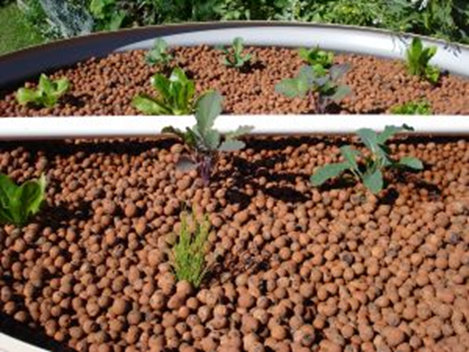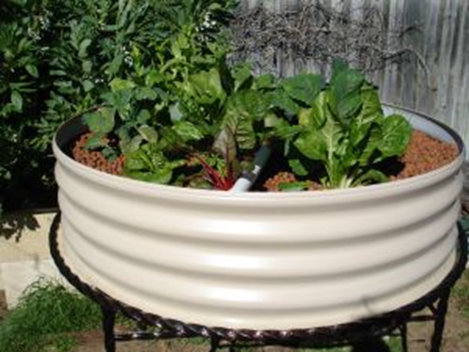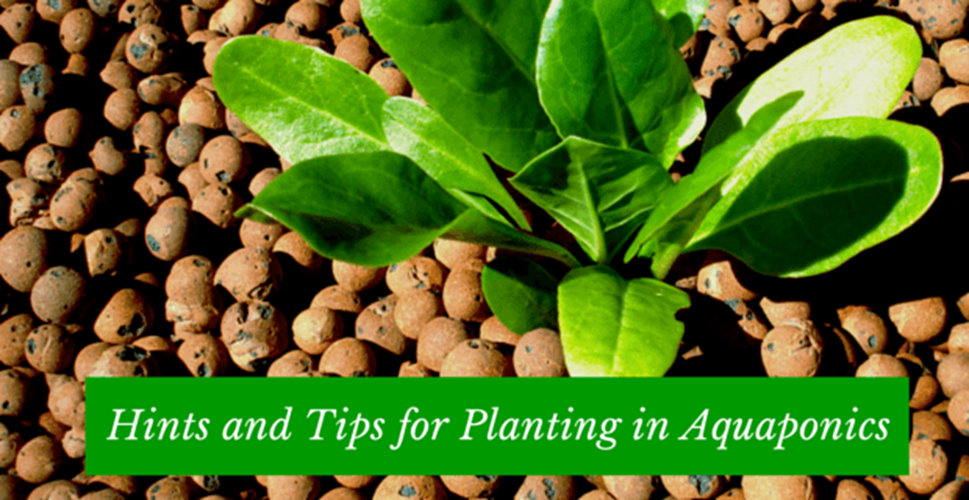These tips will help you make sure you get the plants in your aquaponics system off to the best possible start.
You can grow just about any plant in your aquaponics system, from leafy greens such as lettuce and spinach, to root crops such as carrots and fruiting plants such as tomatoes and strawberries, even paw paw-mango-avocado’s. You can also grow flowers and herbs, or ornamentals such as ferns and palms. Plants can be grown from seeds or seedlings.
And the grow bed isn’t the only place you can grow vegetables in your aquaponics system. You can plant in floating trays on the surface of the water in the fish tank or sump tank. The only trick here is to plant species that don’t mind having their feet wet (roots submerged in water full time). Lettuce is a great example to plant in, water cress too.
If you are planting into a new grow bed it is advisable to plant seedlings rather than seeds, as they are able to start extracting nutrients straight away from the additional feed as the systems microbiome and bacteria colony hasn’t had much building time just yet. Fast growing, low nutrient is the key for the first 3-6 months. After your system has aged (6 months) and has had some established plants go through it is fine to start planting with seeds.
 To prepare the seedlings, submerge the seedlings in a bucket of water mixed with 4 capfuls of liquid seaweed. As the seedlings are likely to be stressed by the planting process, the liquid seaweed plant tonic acts as a stress buffer giving the plants their best chance when settling into their new environment. Give the seedling a good wash in this solution and wash away any soil from the roots being very careful not to damage them too much. The plants are then planted directly into the clay balls or system.
To prepare the seedlings, submerge the seedlings in a bucket of water mixed with 4 capfuls of liquid seaweed. As the seedlings are likely to be stressed by the planting process, the liquid seaweed plant tonic acts as a stress buffer giving the plants their best chance when settling into their new environment. Give the seedling a good wash in this solution and wash away any soil from the roots being very careful not to damage them too much. The plants are then planted directly into the clay balls or system.
Note: You don’t have to strictly wash away all the soil from the roots of the plants. If the soil washes away easily, great! If the roots are holding onto the soil just give the roots a quick massage and see what drops away. It is better to plant a seedling with roots and left over trace soil rather than pick its roots apart trying to remove the soil.
To plant the seedlings, support the roots and stem of the plant in one hand while making a hole in the expanded clay with the other. I like to pinch my fingers together with the roots at the pinch point and top of seedling towards my wrist. Like a shovel, push the seedling into the clay to a depth of about 5-10cm and cover the roots, be careful not to damage the plant with the clay balls falling.
 Liquid seaweed or SF Compost Tea can continue to be added as a foliar spray – to give your plants a boost every so often, simply dilute 2 or 3 capfuls in a 9 litre watering can and apply fortnightly. Once the plants look established limit liquid feed applications to once every 4 weeks.
Liquid seaweed or SF Compost Tea can continue to be added as a foliar spray – to give your plants a boost every so often, simply dilute 2 or 3 capfuls in a 9 litre watering can and apply fortnightly. Once the plants look established limit liquid feed applications to once every 4 weeks.
When deciding on what vegetables to grow, it is important to plant seasonal varieties that thrive in the current climate. A struggling out of season plant will provide no benefit to the system and vice versa.
Plants in your grow bed only compete for sunlight and root space so structure your plantings (aspect) so that large or tall plants (tomatoes, corn etc) are grown on the far side of the grow bed (so that they don’t shade smaller plants). Plant vines such as watermelon and cucumber on the perimeter of the grow bed, allowing them to grow out and along the ground, wall, trellis, fence etc conserving much needed filter real estate.
 Also as the plants do not compete for water or nutrients you can plant in much higher densities than in the ground. Anytime you see a bare patch of expanded clay plant in a new plant or seed.
Also as the plants do not compete for water or nutrients you can plant in much higher densities than in the ground. Anytime you see a bare patch of expanded clay plant in a new plant or seed.
Structure your plantings so that you always have at least half to three quarters of the grow bed growing plants. Plant fast growers such as beans and cucumbers alongside slow growers such as tomatoes and corn. When the fast growers have expired, replace them with slow growers and when the slow growers have expired replace them with fast growers. By keeping half the bed or more planted you ensure you always have plants taking nutrient from the water. Plants in their growing phase are the most benefit to your fish farm system as in the growing stage plants are at their most hungry for nutrients.
 A newly setup aquaponics system won’t have a build-up of organic matter to hold the expanded clay together, so you might find that top heavy plants blow over easily in strong winds. So it’s important to stake these with stakes attached to the outside of the grow bed (don’t push stakes into the expanded clay media) – and don’t use treated wooden stakes.
A newly setup aquaponics system won’t have a build-up of organic matter to hold the expanded clay together, so you might find that top heavy plants blow over easily in strong winds. So it’s important to stake these with stakes attached to the outside of the grow bed (don’t push stakes into the expanded clay media) – and don’t use treated wooden stakes.
Ras Mark Suburban Farmer

